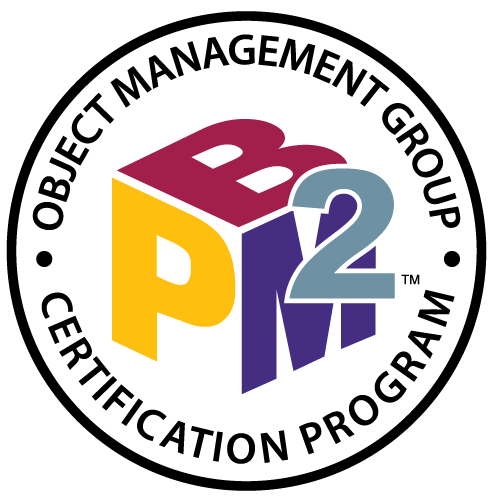Charter
A standard Business Process Model and Notation (BPMN) will provide businesses with the capability of understanding their internal business procedures in a graphical notation and will give organizations the ability to communicate these procedures in a standard manner. Furthermore, the graphical notation will facilitate the understanding of the performance collaborations and business transactions between the organizations. This will ensure that businesses will understand themselves and participants in their business and will enable organizations to adjust to new internal and B2B business circumstances quickly.
Current BPMN Specification
BPM Certification
 The OCEB 2 program consists of five examinations, granting five Certifications. Above the single Fundamental level, the program splits into two tracks - one Business-oriented , the other Technically oriented.
The OCEB 2 program consists of five examinations, granting five Certifications. Above the single Fundamental level, the program splits into two tracks - one Business-oriented , the other Technically oriented.
Credentials are important in the BPM world, where practitioners may work on many projects for different clients or employers over time. The twenty-five experts from top BPM companies and well-known independent consultants who designed the OCEB 2 topical coverage and wrote the exam questions want peers and prospective employers to feel confident about a certified candidate's ability to participate in or lead real-world initiatives in enterprise BPM. Your status as an OCEB 2 Certified Professional shows current and future employers or clients that you have the required knowledge and skills, making you a more attractive candidate for hiring and promotion.
Frequently Asked Questions (FAQ)
What is BPMN?
The Business Process Modeling Notation (BPMN) is a graphical notation that depicts the steps in a business process. BPMN depicts the end to end flow of a business process. The notation has been specifically designed to coordinate the sequence of processes and the messages that flow between different process participants in a related set of activities.
Why is BPMN important?
The world of business processes has changed dramatically over the past few years. Processes can be coordinated from behind, within and over organizations natural boundaries. A business process now spans multiple participants and coordination can be complex. Until BPMN, there has not been a standard modelling technique developed that addresses these issues. BPMN has been developed to provide users with a royalty free notation. This will benefit users in a similar manner in which UML standardised the world of software engineering. There will be training courses, books and a body of knowledge that users can access in order to better implement a business process.
Who is BPMN targeted at?
BPMN is targeted at a high level for business users and at a lower level for process implementers. The business users should be able to easily read and understand a BPMN business process diagram. The process implementer should be able to adorn a business process diagram with further detail in order to represent the process in a physical implementation. BPMN is targeted at users, vendors and service providers that need to communicate business processes in a standard manner.
What does this mean for UML users?
The unified modelling language (UML) takes an object-oriented approach to the modeling of applications, while BPMN takes a process-oriented approach to modelling of systems. Where BPMN has a focus on business processes, the UML has a focus on software design and therefore the two are not competing notations but are different views on systems. The BPMN and the UML are compatible with each other. A business process model does not necessarily have to be implemented as an automated business process in a process execution language. Where this is the case, business processes and participants can be mapped to constructs such as use cases and behavioural models in the UML. Further white papers will follow on the mapping between these techniques.
Will there be a major rewrite?
Not for 2 or 3 years...
What is the relationship between BPMN and BPEL?
BPEL is an XML-based language for describing a business process in which most of the tasks represent interactions between the process and external Web services. The BPEL process itself is represented as a Web service, and is realized by a BPEL engine which executes the process description. BPMN is a standard set of diagramming conventions for describing business processes. It is designed to visualize a rich set of process flow semantics within a process and the communication between independent processes. It is intended to support capture of sufficient detail to allow it to be the source of an executable process description. Since BPEL is currently considered the most important standard for execution languages, a translation to BPEL is specified in the BPMN standard. By design there are some limitations on the process topologies that can be described in BPEL, so it is possible to represent processes in BPMN that cannot be mapped to BPEL. There are a few concepts, such as Ad-Hoc sub-proceses, that BPMN can represent that may not be implemented with any technology.